8. ECA vs ICA - External versus internal carotid artery
 Blood Supply Cerebral. Only the internal carotid arrteries and the vertebral arteries feed blood to the brain
Blood Supply Cerebral. Only the internal carotid arrteries and the vertebral arteries feed blood to the brain
8.1 Why is it important to differentiate the internal- from the external carotid artery with ultrasound?
One of the most frequently asked questions, in carotid ultrasound is: “how can I tell if the vessel I am imaging is the internal- or the external carotid artery?" Especially, since the location of the vessels (and their relationship to each other) vary greatly. It can make quite a difference to the patient if a stenotic lesion or a plaque is located in the internal or external carotid. The internal carotid artery supplies the brain while the external carotid artery supplies extracranial structures of the head and neck. Therefore ischemia or an embolic event will only occur if the internal carotid artery is involved. A plaque or stenosis of the external carotid artery usually has little consequence (unless the external carotid artery provides collateral flow).
8.2 Which morphologic clues help to distinguish the internal- from the external carotid artery?
There are several observations that will help you identify the arteries. The position, size and shape are suggestive of either the internal or external carotid artery. In contrast the presence of side branches clearly denotes that the vessel is the external carotid artery.
Morphologic clues
Position
Large variation of the position in relationship to each other, The ICA is most commonly posterior and lateral to the ECA, When imaging the carotid artery from anterior the ECA will more frequently be closer to the transducer than the ICA
Size
The internal carotid artery (ICA) is more commonly larger than the external carotid artery
Shape
The internal carotid artery (ICA) has the bulb (the vessel is wider at its origin)
Branches
The external carotid artery (ECA) has side branches
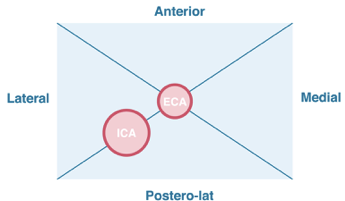 Most common relationship of the external and internal carotid artery in a transverse view
Most common relationship of the external and internal carotid artery in a transverse view
< Previous chapter: 7. Vertebral Arteries Next chapter: 9. ECA vs ICA >
8.3 How can color Doppler help to distinguish the internal from the external artery
There are several ways how both color Doppler and spectral Doppler can help to tell if the vessel you are imaging is the internal or the external artery. For example: you can use both Power Doppler and color Doppler to visualize side branches. Here are two examples.
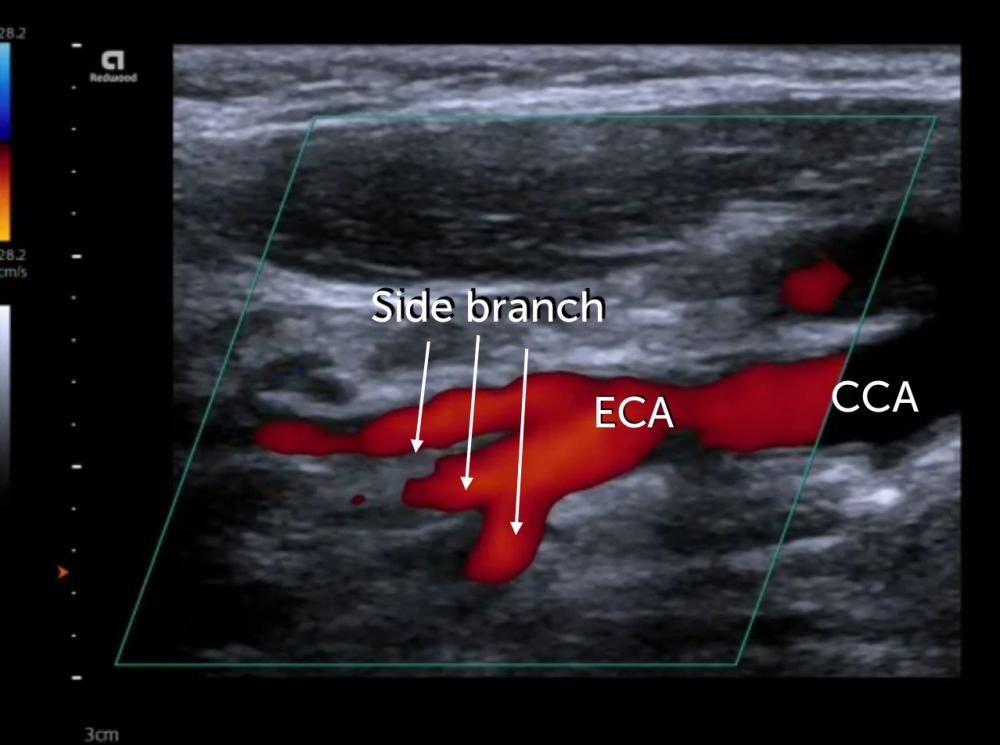 Color Doppler helps to identify multiple side branches of the external carotid artery.
Color Doppler helps to identify multiple side branches of the external carotid artery.
The temporal color Doppler pattern also differs between the external and the internal carotid artery. Because the diastolic velocities are lower in the external versus the internal carotid artery we can also observe less color Doppler filling in the external carotid artery during diastole (there is more “color pulsation”).
Color Doppler also allows you to identify the internal carotid artery by detecting the area of “recirculation” of the internal carotid bulb.
8.4 How is spectral Doppler used to differentiate between the external and internal carotid artery?
There is a distinct difference in the spectral Doppler pattern between the external and internal carotid artery. The external carotid artery supplies a “high” resistance vascular bed”, while the internal carotid artery supplies the brain which has a low resistance vascular bed.
Characteristics:
Internal carotid artery
- Higher diastolic velocities
- Often lower systolic velocities
- (Less difference between max systolic and diastolic velocities)
External carotid artery
- Initial sharp rise in velocity at systole
- Rapid decline in velocity after systole
- Sometimes retrograde flow in diastole
- Lower diastolic velocities
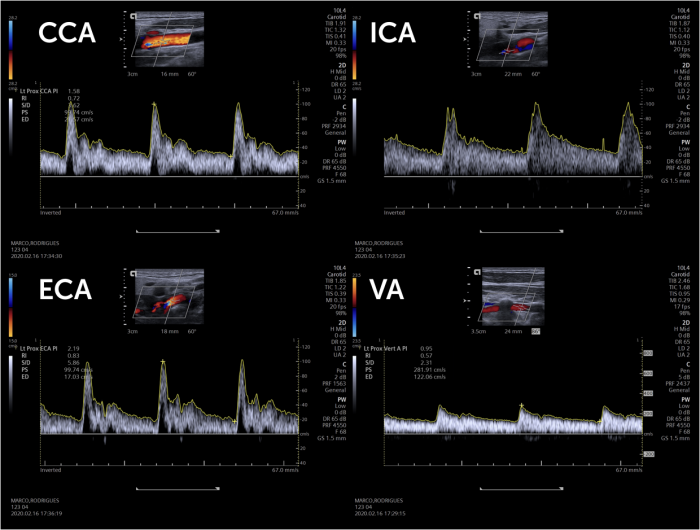 The internal carotid artery is characterized by a lower systolic velocity, a higher diastolic velocity compared to the external carotid artery (S/D ratio of the ICA = 2.6, S/D of the ECA = 4.8). Note the early diastolic dip in the external carotid artery. The velocity sometimes drops below the baseline (retrograde flow)
The internal carotid artery is characterized by a lower systolic velocity, a higher diastolic velocity compared to the external carotid artery (S/D ratio of the ICA = 2.6, S/D of the ECA = 4.8). Note the early diastolic dip in the external carotid artery. The velocity sometimes drops below the baseline (retrograde flow)
Note: There is a certain variation in the characteristics of the internal and external carotid artery and the patterns can sometimes look quite similar, making it difficult to differentiate the vessels. In such situations try imaging the more distal segments of the arteries. The further distal you record the Doppler signal in the internal carotid artery the higher the diastolic component will become (decrease in the S/D ratio) and the easier it will be to differentiate it from the external carotid artery.
8.5 How does the spectrum of the vertebral arteries and the common carotid artery look?
The common carotid artery supplies both a high and a low resistance bed (via the external and internal carotid artery). Therefore, the signal looks like a combination of the internal and external carotid artery. The relationship between the systolic and diastolic maximal velocities is intermediate.
The vertebral artery also supplies the brain with blood. Therefore it is a “low resistance” artery. The Spectral Doppler tracing resembles that of the internal carotid artery with a relative high diastolic velocity.
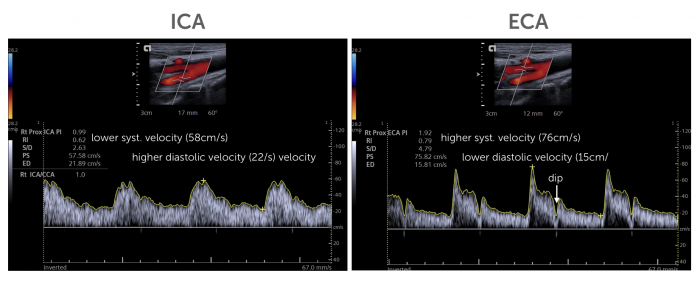 The spectrum of the common carotid artery (CCA) has a higher diastolic velocity than the external carotid artery but lower than the internal carotid artery. The vertebral artery is a low resistance artery, which resembles that of the internal carotid artery.
The spectrum of the common carotid artery (CCA) has a higher diastolic velocity than the external carotid artery but lower than the internal carotid artery. The vertebral artery is a low resistance artery, which resembles that of the internal carotid artery.
8.6 What is the “temporal tap” and how can it be used to differentiate between the internal and the external carotid artery?
The “temporal tap maneuver is used to identify the external carotid artery. Repeated compression (tapping) of the superficial temporal artery (which is located in front of the ear) causes small deflection on the spectral Doppler tracing. The maneuver is not always easy to perform. Be sure that you are really tapping the temporal artery! (you can feel the pulse of the temporal artery anterior to the ear). Perform rapid successive taps. It might be helpful to ask a colleague to perform the maneuver while you image. It is advisable to place the Doppler sample volume as far distal in the artery as possible.
Caution: The temporal tap maneuver is not always reliable as deflection waves can sometimes also be seen in the internal carotid artery.
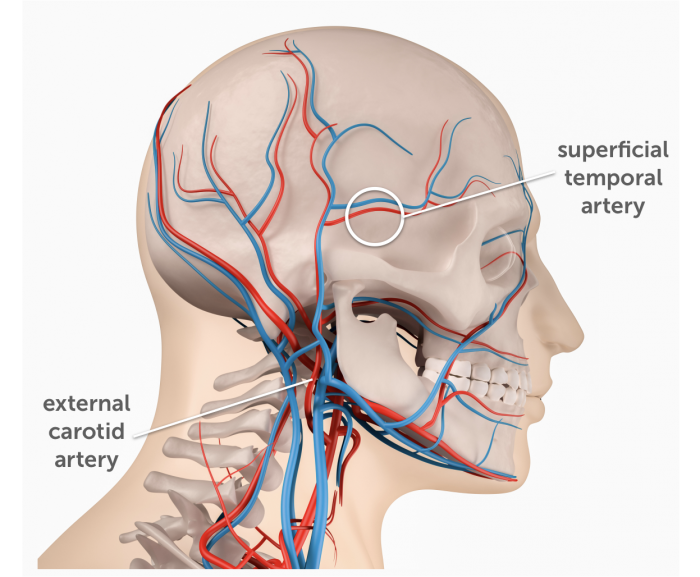 The pulse of the superficial temporal artery (which is a branch of the external carotid artery) can be detected anterior to the ear
The pulse of the superficial temporal artery (which is a branch of the external carotid artery) can be detected anterior to the ear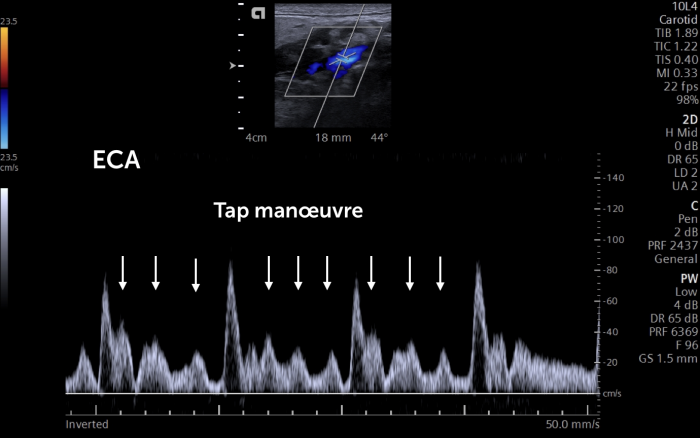 Temporal tap: Rapid compression (tapping) of the superficial temporal artery causes small Doppler waves in the spectrum of the external carotid artery
Temporal tap: Rapid compression (tapping) of the superficial temporal artery causes small Doppler waves in the spectrum of the external carotid artery


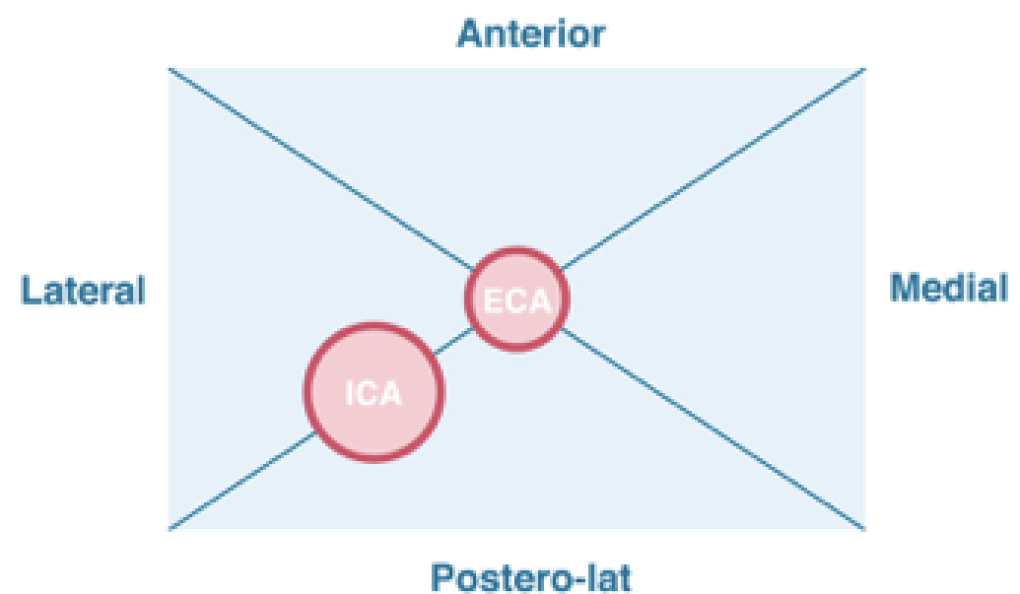
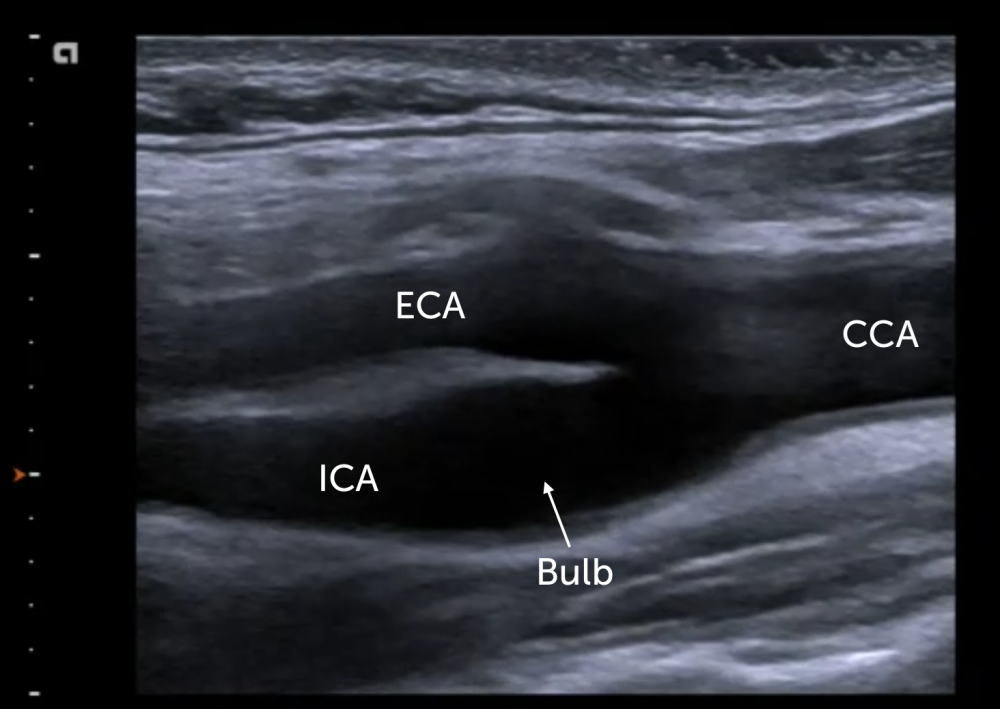 Carotid Bifurcation. The internal carotid artery is located in the far field of the transducer. It is larger than the external carotid artery and it is wider at it’s origin (bulb)
Carotid Bifurcation. The internal carotid artery is located in the far field of the transducer. It is larger than the external carotid artery and it is wider at it’s origin (bulb)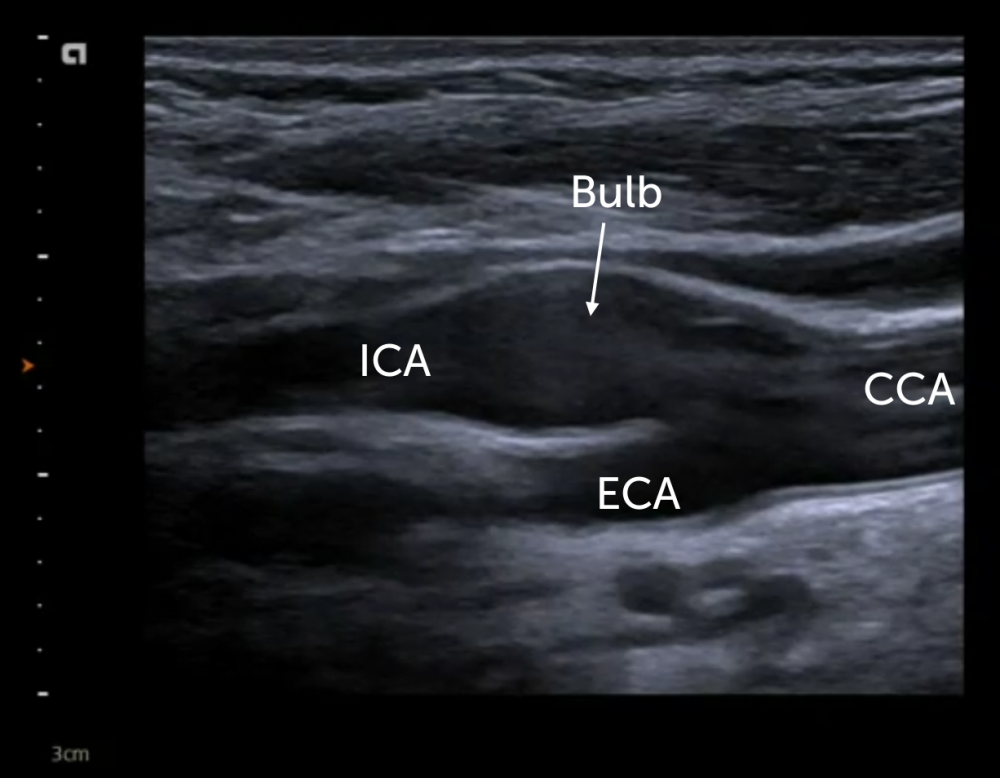 Carotid Bifurcation. The internal carotid artery is located in the near field of the transducer. It is larger than the external carotid artery and it is wider at it’s origin (bulb)
Carotid Bifurcation. The internal carotid artery is located in the near field of the transducer. It is larger than the external carotid artery and it is wider at it’s origin (bulb)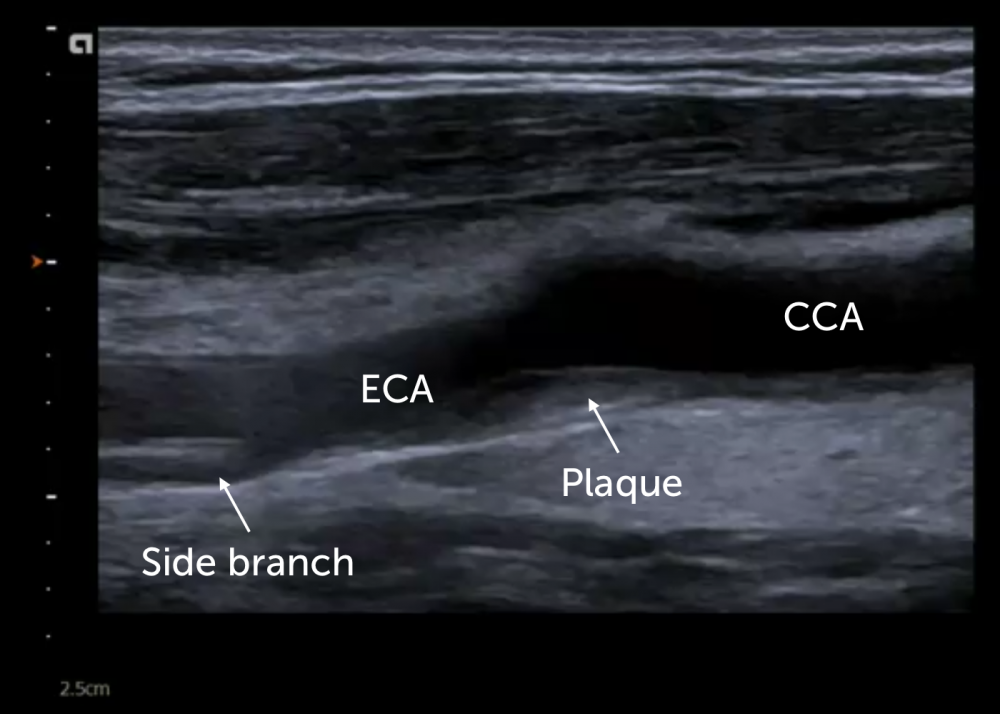 The vessel coming off of the common carotid artery (CCA) must be the external carotid artery (ECA) because it has a “side branch”. Note that a plaque is seen in the external carotid artery.’
The vessel coming off of the common carotid artery (CCA) must be the external carotid artery (ECA) because it has a “side branch”. Note that a plaque is seen in the external carotid artery.’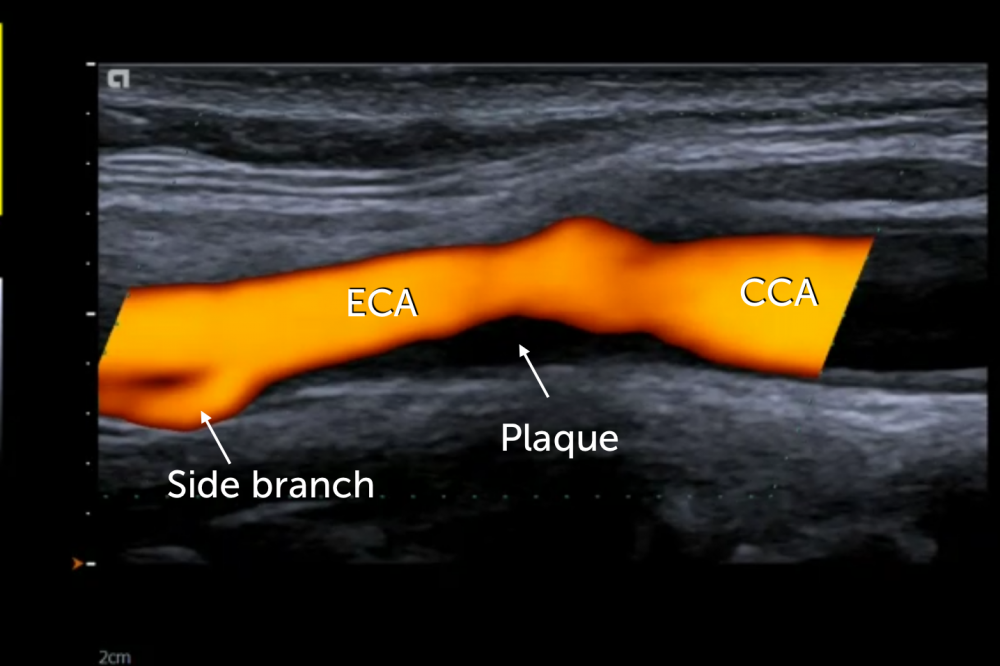 Power Doppler recording of the carotid artery. A side branch of the external carotid artery is visible. The Power Doppler “filling defect” seen in the vessel represents a soft plaque.
Power Doppler recording of the carotid artery. A side branch of the external carotid artery is visible. The Power Doppler “filling defect” seen in the vessel represents a soft plaque.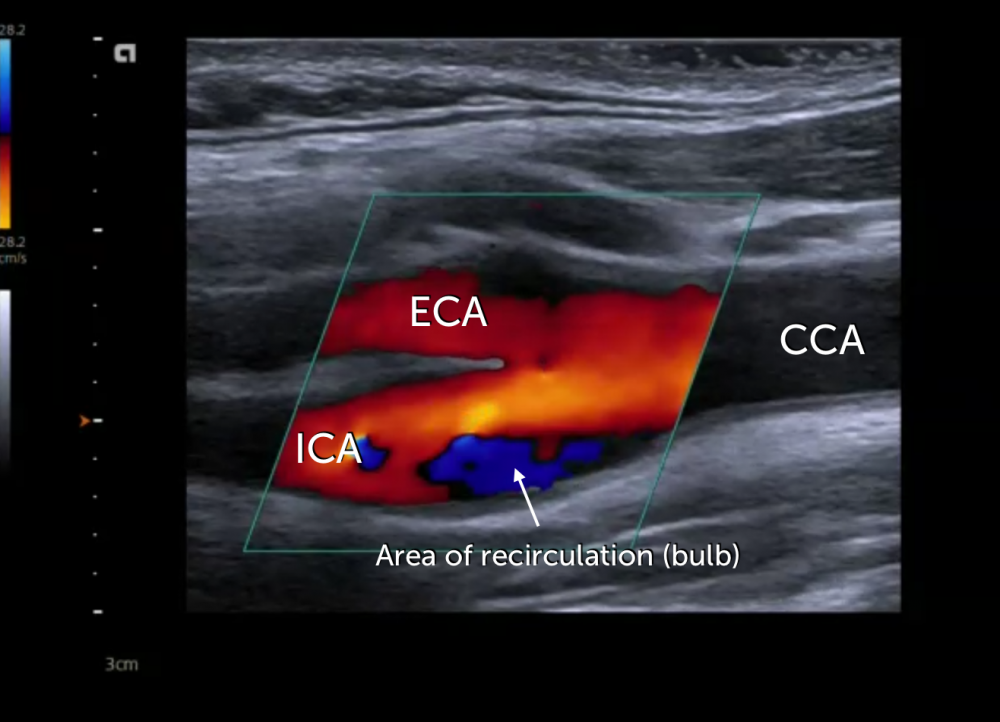 Color Doppler demonstrates the area of recirculation of the carotid bulb. This finding aids in the identification of the internal carotid artery
Color Doppler demonstrates the area of recirculation of the carotid bulb. This finding aids in the identification of the internal carotid artery